JVC KD-R201, KD-R203 User manual
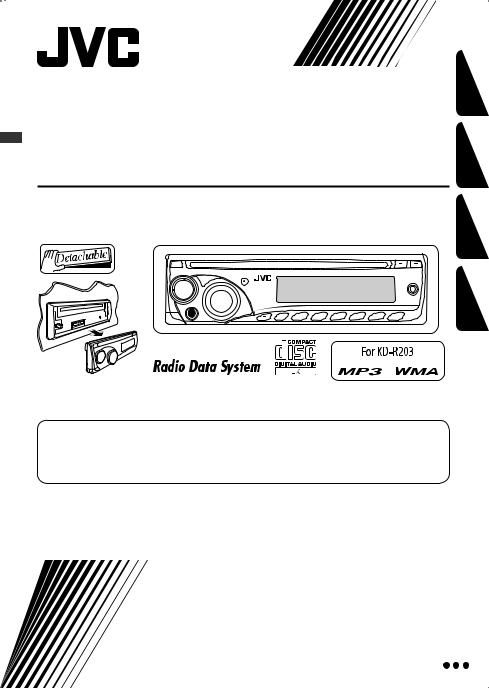
CD RECEIVER
CD-RECEIVER
РЕСИВЕР С ПРОИГРЫВАТЕЛЕМ КОМПАКТ-ДИСКОВ
∆ΕΚΤΗΣ ΜΕ CD
 KD-R203/KD-R201
KD-R203/KD-R201
For canceling the display demonstration, see page 5. Zum Abbrechen der Displaydemonstration siehe Seite 5.
Информацию об отмене демонстрации функций дисплея см. на стр. 5. Για να ακυρώσετε την επίδειξη λειτουργίας στην θóνη, βλ. σελίδα 5.
For installation and connections, refer to the separate manual.
Für den Einbau und die Anschlüsse siehe das eigenständige Handbuch.
Указания по установке и выполнению соединений приводятся в отдельной инструкции.
Για πληρoφoρίες σχετικά µε την εγκατάσταση και τις συνδέσεις, ανατρέξτε στo αντίστoιχo ξεχωριστό εγχειρίδιo.
INSTRUCTIONS
BEDIENUNGSANLEITUNG
ИНСТРУКЦИИ ПО ЭКСПЛУАТАЦИИ
Ο∆ΗΓΙΕΣ
GET0583-006A
ΕΛΛΗΝΙΚΑ РУCCKИЙ DEUTSCH ENGLISH
[EY]

ENGLISH
Thank you for purchasing a JVC product.
Please read all instructions carefully before operation, to ensure your complete understanding and to obtain the best possible performance from the unit.
IMPORTANT FOR LASER PRODUCTS
1.CLASS 1 LASER PRODUCT
2.CAUTION: Do not open the top cover. There are no user serviceable parts inside the unit; leave all servicing to
qualified service personnel.
3. CAUTION: Visible and/or invisible class 1M laser radiation when open. Do not view directly with optical instruments.
4. REPRODUCTION OF LABEL: CAUTION LABEL, PLACED OUTSIDE THE UNIT.
Warning:
If you need to operate the unit while driving, be sure to look around carefully or you may be involved in a traffic accident.
 How to reset your unit
How to reset your unit
• Your preset adjustments will also be erased.
 How to forcibly eject a disc
How to forcibly eject a disc
•Be careful not to drop the disc when it ejects.
•If this does not work, reset your unit.
Battery
Products
Information for Users on Disposal of Old Equipment and Batteries
[European Union only]
These symbols indicate that the product and the battery with this symbol should not be disposed as general household waste at its end-of-life.
If you wish to dispose of this product and the battery, please do so in accordance with applicable national legislation or other rules in your country and municipality.
By disposing of this product correctly, you will help to conserve natural resources and will help prevent potential negative effects on the environment and human health.
Notice:
The sign Pb below the symbol for batteries indicates that this battery contains lead.
2

 How to use the M MODE button
How to use the M MODE button
If you press M MODE, the unit goes into functions mode, then the number buttons and 5 / ∞ buttons will work as different function buttons.
Ex.: When number button 2 works as
MO (monaural) button.
To use these buttons for their original functions again after pressing M MODE, wait for 5 seconds without pressing any of these buttons until the functions mode is cleared, or press M MODE again.
 Detaching the control panel
Detaching the control panel
CONTENTS |
|
Control panel .................................. |
4 |
Getting started................................ |
5 |
Basic operations................................................... |
5 |
Radio operations ............................. |
6 |
FM Radio Data System operations..... |
7 |
Searching for your favorite FM Radio Data System |
|
programme.......................................................... |
7 |
Disc operations................................ |
9 |
Playing a disc in the unit ..................................... |
9 |
Sound adjustments.......................... |
11 |
General settings — PSM .................. |
12 |
Other external component |
|
operations .................................... |
15 |
Maintenance ................................... |
15 |
More about this unit ........................ |
16 |
Troubleshooting.............................. |
18 |
Specifications.................................. |
19 |
ENGLISH
 Attaching the control panel
Attaching the control panel
Caution on volume setting:
Discs produce very little noise compared with other sources. Lower the volume before playing a disc to avoid damaging the speakers by the sudden increase of the output level.
For safety...
•Do not raise the volume level too much, as this will block outside sounds, making driving dangerous.
•Stop the car before performing any complicated operations.
Temperature inside the car...
If you have parked the car for a long time in hot or cold weather, wait until the temperature in the car becomes normal before operating the unit.
3
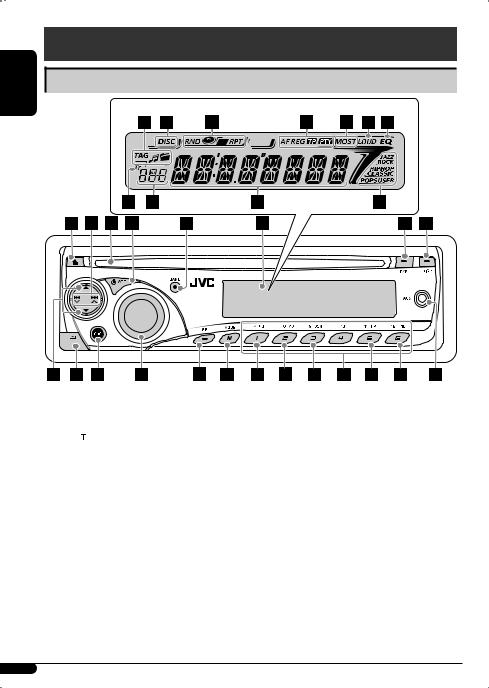
ENGLISH
Control panel
Parts identification
Display window
1 0 (eject) button
2 4 / ¢
/ ¢ buttons
buttons
3 Loading slot
4  (standby/attenuator) button
(standby/attenuator) button
5 BAND button
6 Display window
7 T/P (traffic programme/programme type) button
8 DISP (display) button
9 5(up)/∞(down) buttons
p  (control panel release) button q SRC (source) button
(control panel release) button q SRC (source) button
w Control dial
e SEL (select) button r M MODE button
t EQ (equalizer) button y MO (monaural) button
u SSM (Strong-station Sequential Memory) button i Number buttons
o RPT (repeat) button ; RND (random) button
a AUX (auxiliary) input jack
s Disc information indicators —
TAG* (Tag information), (track/file),
(track/file),  * (folder)
* (folder)
d DISC indicator
fPlayback mode / item indicators— RND (random),  (disc),
(disc), * (folder), RPT (repeat)
* (folder), RPT (repeat)
g Radio Data System indicators—AF, REG, TP, PTY
hTuner reception indicators—MO (monaural), ST (stereo)
j LOUD (loudness) indicator k EQ (equalizer) indicator l Tr (track) indicator
/Source display / Track number / Volume level indicator / Time countdown indicator
z Main display
xSound mode (c-EQ: custom equalizer) indicators— JAZZ, ROCK, HIP HOP, CLASSIC, POPS, USER
* For KD-R203
4
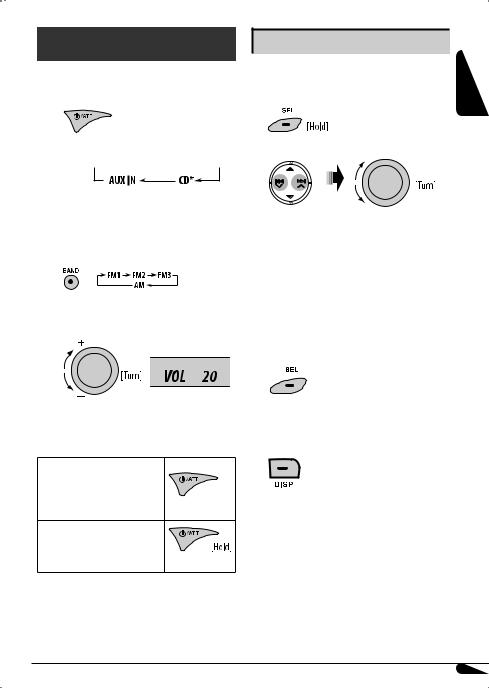
Getting started
Basic operations 
~ Turn on the power.
Ÿ









* You cannot select “CD” as the playback source if there is no disc in the unit.
! For FM/AM tuner
⁄ Adjust the volume.
Volume level appears.
@Adjust the sound as you want. (See pages 11 and 12.)
To drop the volume in a moment (ATT)
To restore the sound, press the button again.
To turn off the power
Basic settings
• See also “General settings — PSM” on |
ENGLISH |
|
|
pages 12 – 14. |
|
1 |
|
2
1Canceling the display demonstrations
Select “DEMO,” then “DEMO OFF.”
2Setting the clock
Select “CLOCK H” (hour), then adjust the hour. Select “CLOCK M” (minute), then adjust the minute.
Select “24H/12H,” then “24H” (hour) or “12H” (hour).
3 Finish the procedure.
To check the current clock time while the power is turned off
Clock time is shown on the display for about 5 seconds. See also page 13.
5
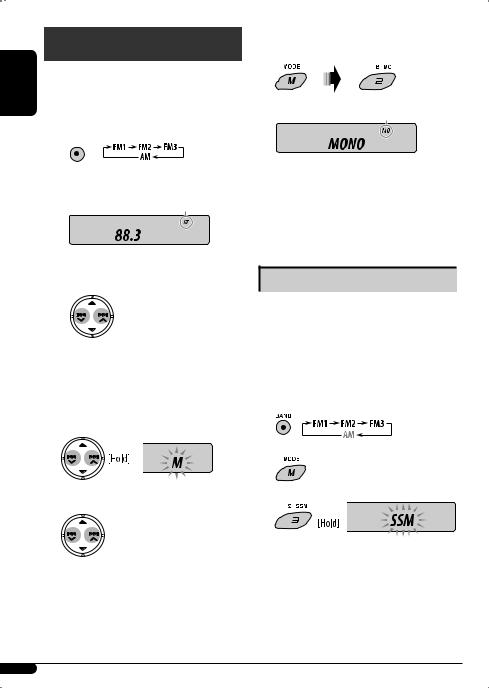
Radio operations
ENGLISH ~ 










Ÿ 

Lights up when receiving an FM stereo broadcast with sufficient signal strength.
!Start searching for a station.
When a station is received, searching stops. To stop searching, press the same button again.
To tune in to a station manually
In step ! above...
1
2 Select a desired station frequency.
When an FM stereo broadcast is hard to receive
Lights up when monaural mode is activated.
Reception improves, but the stereo effect will be lost.
To restore the stereo effect, repeat the same procedure. “MONO OFF” appears and the MO indicator goes off.
Storing stations in memory
You can preset six stations for each band.
 FM station automatic presetting— SSM (Strong-station Sequential Memory)
FM station automatic presetting— SSM (Strong-station Sequential Memory)
1Select the FM band (FM1 – FM3) you want to store into.
2
3
“SSM” flashes, then disappears when automatic presetting is over.
Local FM stations with the strongest signals are searched and stored automatically in the FM band.
6
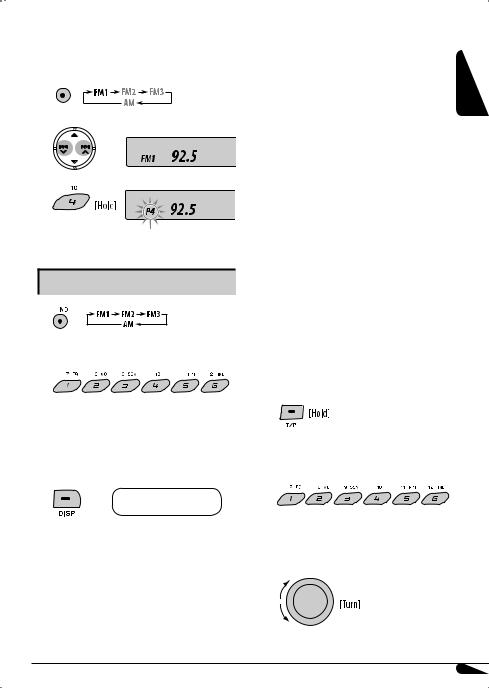
 Manual presetting
Manual presetting
Ex.: Storing the FM station of 92.5 MHz into preset number 4 of the FM1 band.
1 

2
3
Preset number flashes for a while.
Listening to a preset station
1 
2 Select the preset station (1 – 6) you want.
To check the current clock time while listening to an FM (non-Radio Data System) or AM station
• For FM Radio Data System stations, see page 9.
Frequency Ô Clock
FM Radio Data System |
|
|
operations |
ENGLISH |
|
|
||
What you can do with Radio Data System |
||
|
||
Radio Data System allows FM stations to send an |
|
|
additional signal along with their regular programme |
|
|
signals. |
|
By receiving the Radio Data System data, this unit can do the following:
•Programme Type (PTY) Search (see the following)
•TA (Traffic Announcement) and PTY Standby Receptions (see pages 8, 9, 13 and 14)
•Tracing the same programme automatically —Network-Tracking Reception (see page 9)
•Programme Search (see pages 9 and 14)
Searching for your favorite FM Radio Data System programme 
You can tune in to a station broadcasting your favorite programme by searching for a PTY code.
• To store your favorite programme types, see page 8.
~ |
The last selected PTY |
|
code appears. |
ŸSelect one of your favorite programme types.
or
Select one of the PTY codes (see page 9).
Continued on the next page
7
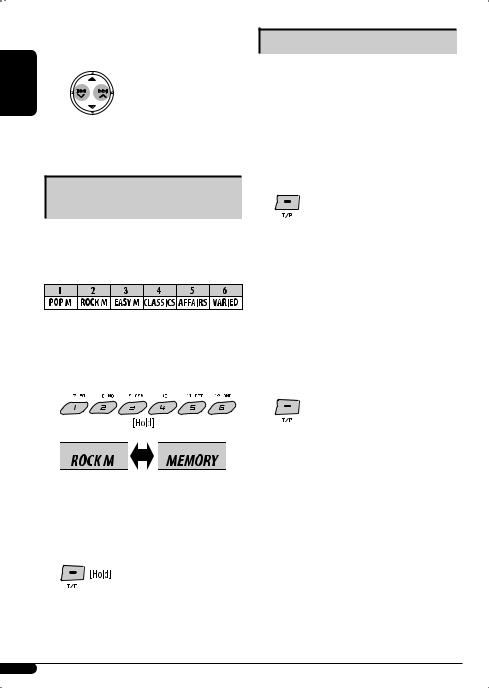
|
! Start searching for your favorite |
ENGLISH |
programme. |
|
If there is a station broadcasting a programme of the same PTY code as you have selected, that station is tuned in.
Storing your favorite programme types
You can store six favorite programme types.
Preset programme types in the number buttons (1 to 6):
1 Select a PTY code (see pages 7 and 8).
2Select the preset number (1 – 6) you want to store into.
Using the standby receptions
 TA Standby Reception
TA Standby Reception
TA Standby Reception allows the unit to switch temporarily to Traffic Announcement (TA) from any source other than AM.
The volume changes to the preset TA volume level if the current level is lower than the preset level (see
page 14).
To activate TA Standby Reception
The TP (Traffic Programme) indicator either lights up or flashes.
•If the TP indicator lights up, TA Standby Reception is activated.
•If the TP indicator flashes, TA Standby Reception is not yet activated. (This occurs when you are listening to an FM station without the Radio Data System signals required for TA Standby Reception.)
To activate TA Standby Reception, tune in to another station providing these signals. The TP indicator will stop flashing and remain lit.
To deactivate the TA Standby Reception
The TP indicator goes off.
Ex.: When “ROCK M” is selected
3Repeat steps 1 and 2 to store other PTY codes into other preset numbers.
4 Finish the procedure.
 PTY Standby Reception
PTY Standby Reception
PTY Standby Reception allows the unit to switch temporarily to your favorite PTY programme from any source other than AM.
To activate and select your favorite PTY code for PTY Standby Reception, see page 13.
The PTY indicator either lights up or flashes.
•If the PTY indicator lights up, PTY Standby Reception is activated.
•If the PTY indicator flashes, PTY Standby Reception is not yet activated.
To activate PTY Standby Reception, tune in to another station providing these signals. The PTY indicator will stop flashing and remain lit.
8
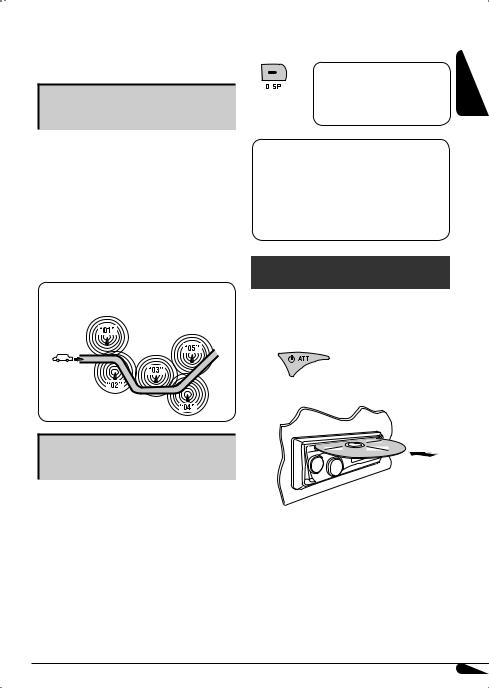
To deactivate the PTY Standby Reception, select “OFF” for the PTY code (see page 13). The PTY indicator goes off.
Tracing the same programme— Network-Tracking Reception
When driving in an area where FM reception is not sufficient enough, this unit automatically tunes in to another FM Radio Data System station of the same network, possibly broadcasting the same programme with stronger signals (see the illustration below).
When shipped from the factory, Network-Tracking Reception is activated.
To change the Network-Tracking Reception setting, see “AF-REG” on page 13.
Programme A broadcasting on different frequency areas (01 – 05)
To check the current clock time while |
|
|
listening to an FM Radio Data System station |
ENGLISH |
|
|
Station name (PS) = Station |
|
|
|
|
|
Frequency = Programme |
|
|
|
|
|
|
|
|
type (PTY) = Clock = (back to |
|
|
the beginning) |
|
PTY codes
NEWS, AFFAIRS, INFO, SPORT, EDUCATE, DRAMA, CULTURE, SCIENCE, VARIED, POP M (music), ROCK M (music), EASY M (music), LIGHT M (music), CLASSICS, OTHER M (music), WEATHER, FINANCE, CHILDREN, SOCIAL, RELIGION, PHONE IN, TRAVEL, LEISURE, JAZZ, COUNTRY, NATION M (music), OLDIES, FOLK M (music), DOCUMENT
Disc operations
Playing a disc in the unit 
~ Turn on the power.
Ÿ
Automatic station selection— Programme Search
Usually when you press the number buttons, the preset station is tuned in.
If the signals from the FM Radio Data System preset station are not sufficient for good reception, this unit, using the AF data, tunes in to another frequency broadcasting the same programme as the original preset station is broadcasting.
•The unit takes some time to tune in to another station using programme search.
•See also page 14.
All tracks will be played repeatedly until you change the source or eject the disc.
Continued on the next page
9
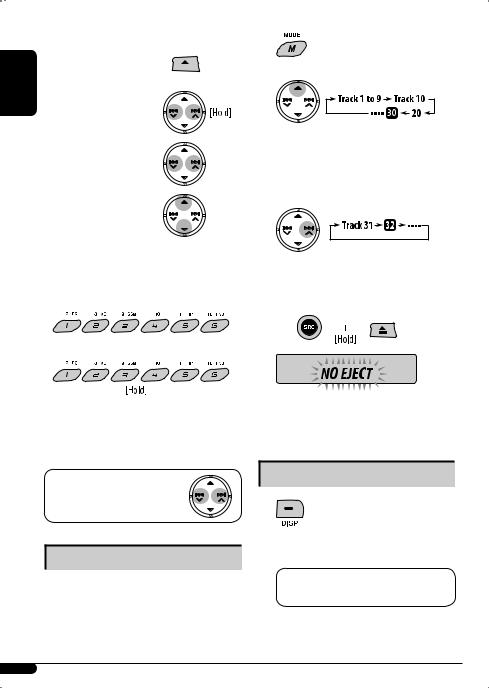
|
To stop play and eject |
|
||||
ENGLISH |
the disc |
|
||||
• Press SRC to listen to |
|
|
|
|
|
|
|
|
|
|
|||
|
another playback source. |
|
||||
|
To fast-forward or reverse |
|
||||
|
the track |
|
|
|
||
|
|
|||||
|
|
|
|
|
|
|
|
To go to the next or |
|
||||
|
previous track |
|
||||
|
|
|
|
|
|
|
|
KD-R203: To go to the |
|
||||
|
next or previous folder |
|
||||
|
(only for MP3 or WMA |
|
||||
|
discs) |
|
||||
To locate a particular track (for CD) or folder (for KD-R203: MP3 or WMA discs) directly
To select a number from 01 – 06:
To select a number from 07 – 12:
•KD-R203: To use direct folder access on MP3/WMA discs, it is required that folders are assigned with 2-digit numbers at the beginning of their folder names—01, 02, 03, and so on.
KD-R203: To select a particular track in a folder (for MP3 or WMA disc):
Other main functions
 Skipping tracks quickly during play
Skipping tracks quickly during play
•KD-R203: For MP3 or WMA discs, you can skip tracks within the same folder.
Ex.: To select track 32 while playing a track whose number is a single digit (1 to 9)
1
2
Each time you press the button, you can skip 10 tracks.
•After the last track, the first track will be selected and vice versa.
3
 Prohibiting disc ejection
Prohibiting disc ejection
You can lock a disc in the loading slot.
To cancel the prohibition, repeat the same procedure.
Changing the display information
 While playing an audio CD or CD Text
While playing an audio CD or CD Text
A = B = Disc title/performer*1 = Track title*1 [ ] = (back to the beginning)
] = (back to the beginning)
10
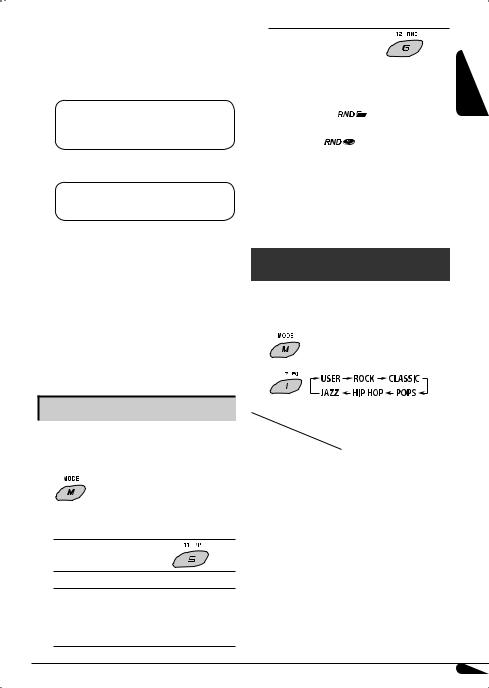
 While playing an MP3 or a WMA track (for KD-R203)
While playing an MP3 or a WMA track (for KD-R203)
•When “TAG DISP” is set to “TAG ON” (see page 14)
A = B = Album name/performer (folder name*2) [
 ] = Track title (file name*2) [
] = Track title (file name*2) [
 ] = (back to the beginning)
] = (back to the beginning)
•When “TAG DISP” is set to “TAG OFF”
A = B = Folder name [ ] = File name
] = File name
[  ] = (back to the beginning)
] = (back to the beginning)
A : The elapsed playing time with the current track number
B : Clock with the current track number
[ ] : Corresponding indicator lights up on the display.
*1 If the current disc is an audio CD, “NO NAME” appears. *2 KD-R203: If an MP3/WMA file does not have Tag
information, folder name and file name appear. In this case, the TAG indicator will not light up.
Selecting the playback modes
You can use only one of the following playback modes at a time.
1
2 Select your desired playback mode.
7 Repeat play
Mode Plays repeatedly
TRK RPT : The current track. [
 ] FLDR RPT* : All tracks of the current folder.
] FLDR RPT* : All tracks of the current folder.
[

 ] RPT OFF : Cancels.
] RPT OFF : Cancels.
7 Random play
|
|
|
ENGLISH |
|
Mode |
Plays at random |
|||
|
||||
FLDR RND* : All tracks of the current folder, then |
|
|||
|
the tracks of the next folder and so |
|
||
|
on. [ |
] |
|
|
ALL RND : All tracks of the current disc. |
|
|||
|
[ |
] |
|
|
RND OFF |
: Cancels. |
|
|
|
*KD-R203: Only while playing an MP3 or a WMA disc.
[ ] : Corresponding indicator lights up on the display.
Sound adjustments
You can select a preset sound mode suitable to the music genre (c-EQ: custom equalizer).
1
2
Preset values |
BAS |
TRE |
LOUD |
|
|
||||
Indication (For) |
(bass) |
(treble) |
(loudness) |
|
|
|
|
||
USER |
00 |
00 |
OFF |
|
(Flat sound) |
||||
|
|
|
||
ROCK |
+03 |
+01 |
ON |
|
(Rock or disco music) |
||||
|
|
|
||
CLASSIC |
+01 |
–02 |
OFF |
|
(Classical music) |
||||
|
|
|
||
POPS |
+04 |
+01 |
OFF |
|
(Light music) |
||||
|
|
|
||
HIP HOP |
+02 |
00 |
ON |
|
(Funk or rap music) |
||||
|
|
|
||
JAZZ |
+02 |
+03 |
OFF |
|
(Jazz music) |
||||
|
|
|
||
|
Continued on the next page |
|||
11
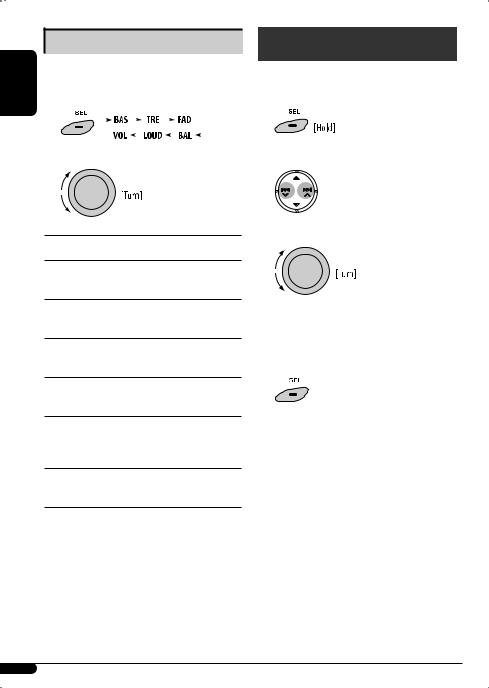
Adjusting the sound
ENGLISH |
You can adjust the sound characteristics to your |
|||||||||||||
|
||||||||||||||
|
preference. |
|||||||||||||
|
1 |
|
|
|
|
|
|
|
|
|
|
|
|
|
|
|
|
|
|
|
|
|
|
|
|
|
|
|
|
2
Indication, [Range]
BAS*1 (bass), [–06 to +06]
Adjust the bass.
TRE*1 (treble), [–06 to +06]
Adjust the treble.
FAD*2 (fader), [R06 to F06]
Adjust the front and rear speaker balance.
BAL (balance), [L06 to R06]
Adjust the left and right speaker balance.
LOUD*1 (loudness), [LOUD ON or LOUD OFF] Boost low and high frequencies to produce a well-balanced sound at a low volume level.
VOL (volume), [00 to 50 or 00 to 30]*3
Adjust the volume.
*1 When you adjust the bass, treble, or loudness, the adjustment you have made is stored for the currently selected sound mode (c-EQ) including “USER.”
*2 If you are using a two-speaker system, set the fader level to “00.”
*3 Depending on the amplifier gain control setting. (See page 14 for details.)
General settings — PSM
You can change PSM (Preferred Setting Mode) items listed on pages 13 and 14.
1
2 Select a PSM item.
3 Adjust the PSM item selected.
4Repeat steps 2 and 3 to adjust other PSM items if necessary.
5 Finish the procedure.
12
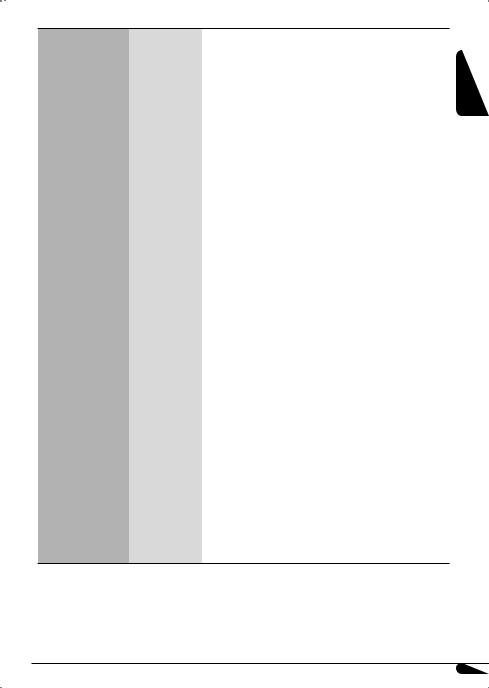
Indications |
Item |
Selectable settings, [reference page] |
|||
|
( |
: Initial) |
|
|
|
|
|
|
|
|
|
DEMO |
• |
DEMO ON |
: Display demonstration will be activated automatically if no |
||
Display demonstration |
|
|
|
|
operation is done for about 20 seconds, [5]. |
|
• |
DEMO OFF |
: |
Cancels. |
|
|
|
|
|
|
|
CLK DISP *1 |
• |
ON |
: Clock time is shown on the display at all times when the power is |
||
Clock display |
|
|
|
|
turned off. |
|
• |
OFF |
: Cancels; pressing DISP will show the clock time for about |
||
|
|
|
|
|
5 seconds when the power is turned off, [5]. |
|
|
|
|
||
CLOCK H |
0 – 23 (1 – 12) |
[Initial: 0 (0:00)], [5]. |
|||
Hour adjustment |
|
|
|
|
|
|
|
|
|
||
CLOCK M |
00 – 59 |
[Initial: 00 (0:00)], [5]. |
|||
Minute adjustment |
|
|
|
|
|
|
|
|
|
|
|
24H/12H |
• |
24H |
: |
See also page 5 for setting. |
|
Time display mode |
• |
12H |
|
|
|
|
|
|
|
|
|
CLK ADJ *2 |
• |
AUTO |
: The built-in clock is automatically adjusted using the CT (clock |
||
Clock adjustment |
|
|
|
|
time) data in the Radio Data System signal. |
|
• |
OFF |
: |
Cancels. |
|
|
|
|
|
|
|
AF-REG *2 |
• |
AF |
: When the currently received signals become weak, the unit |
||
Alternative frequency/ |
|
|
|
|
switches to another station (the programme may differ from the |
regionalization |
|
|
|
|
one currently received), [9, 16]. |
reception |
|
|
|
|
• The AF indicator lights up. |
|
• AF REG |
: When the currently received signals become weak, the unit |
|||
|
|
|
|
|
switches to another station broadcasting the same programme. |
|
|
|
|
|
• The AF and REG indicators light up. |
|
• OFF |
: |
Cancels. |
||
|
|
|
|
||
PTY-STBY *2 |
OFF, PTY codes |
Activates PTY Standby Reception with one of the PTY codes, [9]. |
|||
PTY standby |
|
|
|
|
|
*1 If the power supply is not interrupted by turning off the ignition key of your car, it is recommended that you select “OFF” to save the car’s battery.
*2 Only for FM Radio Data System stations.
ENGLISH
Continued on the next page
13

ENGLISH
Indications |
Item |
Selectable settings, [reference page] |
||||
|
|
( |
|
: Initial) |
|
|
|
|
|
|
|
|
|
TA VOL *2 |
VOL 00 |
[Initial: VOL 15] |
||||
Traffic announcement |
– VOL 50 |
|
|
|||
volume |
(or VOL 00 |
|
|
|||
|
|
– VOL 30)*3 |
|
|
||
|
|
|
|
|
||
P-SEARCH *2 |
• ON |
: |
Activates Programme Search, [9]. |
|||
Programme search |
• |
OFF |
: |
Cancels. |
||
|
|
|
|
|
||
DIMMER |
• ON |
: |
Dims the display and button illumination. |
|||
Dimmer |
• |
OFF |
: |
Cancels. |
||
|
|
|
|
|
||
TEL |
• MUTING 1/ |
: |
Select either one which mutes the sounds while using a cellular |
|||
Telephone muting |
|
MUTING 2 |
|
phone. |
||
|
|
• |
OFF |
: |
Cancels. |
|
|
|
|
|
|
||
SCROLL *4 |
• ONCE |
: |
Scrolls the displayed information once. |
|||
Scroll |
• AUTO |
: |
Repeats scrolling (at 5-second intervals). |
|||
|
|
• OFF |
: |
Cancels. |
||
|
|
|
|
|
• |
Pressing DISP for more than one second can scroll the display |
|
|
|
|
|
|
regardless of the setting. |
|
|
|
|
|||
AUX ADJ |
A.ADJ 00 |
: Adjust the auxiliary input level to avoid the sudden increase of the |
||||
Auxiliary input level |
— A.ADJ 05 |
|
output level when changing the source from external component |
|||
adjustment |
|
|
|
|
connected to the AUX input jack on the control panel. |
|
|
|
|
|
|||
TAG DISP (for KD-R203) |
• TAG ON |
: Shows the Tag information while playing MP3/WMA tracks, [11]. |
||||
Tag display |
• TAG OFF |
: |
Cancels. |
|||
|
|
|
|
|||
AMP GAIN |
• LOW PWR |
: VOL 00 – VOL 30 (Select this if the maximum power of the speaker |
||||
Amplifier gain control |
|
|
|
|
is less than 50 W to prevent damaging the speaker.) |
|
|
|
• |
HIGH PWR |
: VOL 00 – VOL 50 |
||
|
|
|
|
|||
IF BAND |
• AUTO |
: Increases the tuner selectivity to reduce interference noise between |
||||
Intermediate frequency |
|
|
|
|
close stations. (Stereo effect may be lost.) |
|
band |
• WIDE |
: Subject to the interference noise from adjacent stations, but sound |
||||
|
|
|
|
|
|
quality will not be degraded and the stereo effect will remain. |
|
|
|
|
|
||
*2 |
Only for FM Radio Data System stations. |
|
|
|||
*3 |
Depends on the amplifier gain control. |
|
|
|||
*4 |
Some characters or symbols will not be shown correctly (or will be blanked) on the display. |
|||||
14
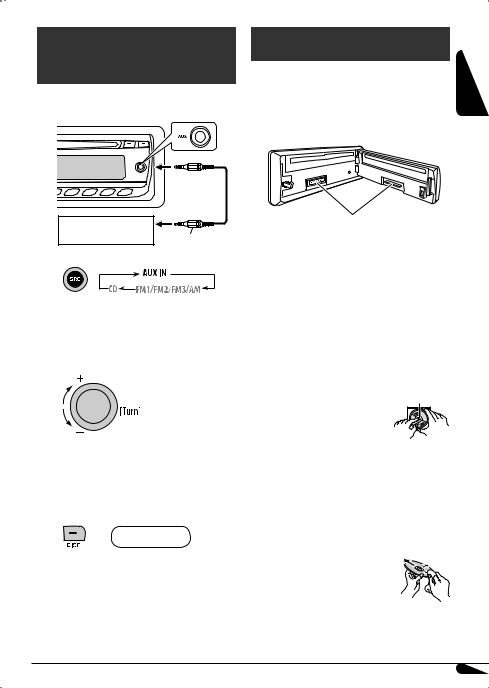
Other external component operations
You can connect an external component to the AUX (auxiliary) input jack on the control panel.
Maintenance
 How to clean the connectors
How to clean the connectors
Frequent detachment will deteriorate the connectors. To minimize this possibility, periodically wipe the connectors with a cotton swab or cloth moistened with alcohol, being careful not to damage the connectors.
ENGLISH
Portable audio player, |
|
etc. |
Stereo mini plug |
|
(not supplied) |
~
ŸTurn on the connected component and start playing the source.
! Adjust the volume.
⁄Adjust the sound as you want. (See pages 11 and 12.)
To check the clock time while listening to an external component
AUX IN ÔClock
Connectors
 Moisture condensation
Moisture condensation
Moisture may condense on the lens inside the unit in the following cases:
•After starting the heater in the car.
•If it becomes very humid inside the car.
Should this occur, the unit may malfunction. In this case, eject the disc and leave the unit turned on for a few hours until the moisture has evaporated.
 How to handle discs
How to handle discs
When removing a disc from its |
Center holder |
case, press down the center holder |
|
of the case and lift the disc out, |
|
holding it by the edges. |
|
•Always hold the disc by the edges. Do not touch its recording surface.
When storing a disc in its case, gently insert the disc around the center holder (with the printed surface facing up).
• Make sure to store discs in cases after use.
 To keep discs clean
To keep discs clean
A dirty disc may not play correctly.
If a disc does become dirty, wipe it with a soft cloth in a straight line from center to edge.
•Do not use any solvents (for example,
conventional record cleaner, spray, thinner, benzine, etc.) to clean discs.
Continued on the next page
15
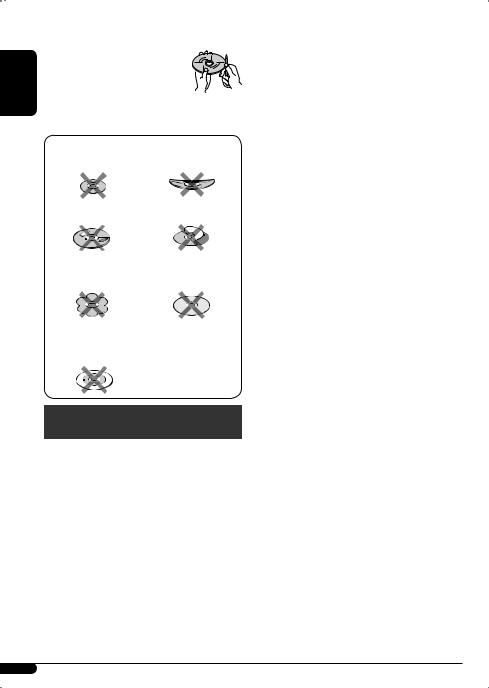
 To play new discs
To play new discs
ENGLISH |
New discs may have some rough spots |
||
around the inner and outer edges. If |
|||
|
|||
|
such a disc is used, this unit may reject |
||
|
the disc. |
|
|
|
To remove these rough spots, rub the edges with a |
||
|
pencil or ball-point pen, etc. |
|
|
|
Do not use the following discs: |
||
|
Single CD (8 cm disc) |
Warped disc |
|
|
Sticker and sticker residue |
Stick-on label |
|
|
Unusual shape |
C-thru Disc (semi- |
|
|
|
transparent disc) |
|
Transparent or semitransparent parts on its recording area
More about this unit
Basic operations 
Turning on the power
•By pressing SRC on the unit, you can also turn on the power. If the source is ready, playback also starts.
Turning off the power
•If you turn off the power while listening to a disc, disc play will start from where it had been stopped previously next time you turn on the power.
Tuner operations 
Storing stations in memory
•During SSM search...
–All previously stored stations are erased and the stations are stored anew.
–Received stations are preset in No. 1 (lowest frequency) to No. 6 (highest frequency).
–When SSM is over, the station stored in No. 1 will be automatically tuned in.
•When storing a station manually, the previously preset station is erased when a new station is stored in the same preset number.
FM Radio Data System operations
•Network-Tracking Reception requires two types of Radio Data System signals—PI (Programme Identification) and AF (Alternative Frequency) to work correctly. Without receiving these data correctly, Network-Tracking Reception will not operate correctly.
•If a Traffic Announcement is received by TA Standby Reception, the volume level automatically changes to the preset level (TA VOL) if the current level is lower than the preset level.
•When Alternative Frequency Reception is activated (with AF selected), Network-Tracking Reception is also activated automatically. On the other hand, Network-Tracking Reception cannot be deactivated without deactivating Alternative Frequency Reception. (See page 13.)
Disc operations 
Caution for DualDisc playback
•The Non-DVD side of a “DualDisc” does not comply with the “Compact Disc Digital Audio” standard. Therefore, the use of Non-DVD side of a DualDisc on this product may not be recommended.
General
•This unit has been designed to reproduce CDs/CD Texts, and CD-Rs (Recordable)/CD-RWs (Rewritable) in audio CD (CD-DA), MP3/WMA (for KD-R203) formats.
•KD-R203: MP3 and WMA “tracks” (words “file” and “track” are used interchangeably) are recorded in “folders.”
•KD-R203: While fast-forwarding or reversing on an MP3 or WMA disc, you can only hear intermittent sounds.
Playing a CD-R or CD-RW
• Use only “finalized” CD-Rs or CD-RWs.
16

•KD-R203: This unit can only play back files of the same type as those which are detected first if a disc includes both audio CD (CD-DA) files and MP3/WMA files.
•This unit can play back multi-session discs; however, unclosed sessions will be skipped while playing.
•Some CD-Rs or CD-RWs may not be played back on this unit because of their disc characteristics, or for the following reasons:
–Discs are dirty or scratched.
–Moisture condensation has occurred on the lens inside the unit.
–The pickup lens inside the unit is dirty.
–The files on the CD-R/CD-RW are written using the “Packet Write” method.
–There are improper recording conditions (missing data, etc.) or media conditions (stained, scratched, warped, etc.).
•CD-RWs may require a longer readout time since the reflectance of CD-RWs is lower than that of regular CDs.
•Do not use the following CD-Rs or CD-RWs:
–Discs with stickers, labels, or protective seal stuck to the surface.
–Discs on which labels can be directly printed by an
ink jet printer.
Using these discs under high temperature or high humidity may cause malfunctions or damage to the unit.
Playing an MP3/WMA disc (for KD-R203)
•This unit can play back MP3/WMA files with the extension code <.mp3> or <.wma> (regardless of the letter case—upper/lower).
•This unit can show the names of albums, artists (performer), and Tag (Version 1.0, 1.1, 2.2, 2.3, or 2.4) for MP3 files and for WMA files.
•This unit can display only one-byte characters. No other characters can be correctly displayed.
•This unit can play back MP3/WMA files meeting the conditions below:
–Bit rate: 8 kbps — 320 kbps
–Sampling frequency:
48 kHz, 44.1 kHz, 32 kHz (for MPEG-1) 24 kHz, 22.05 kHz, 16 kHz (for MPEG-2)
–Disc format: ISO 9660 Level 1/ Level 2, Romeo, Joliet, Windows long file name
•The maximum number of characters for file/folder names vary depending on the disc format used (includes 4 extension characters—<.mp3> or <.wma>).
–ISO 9660 Level 1: up to 12 characters
–ISO 9660 Level 2: up to 31 characters
–Romeo: up to 128 characters
–Joliet: up to 64 characters
–Windows long file name: up to 128 characters
•This unit can recognize a total of 512 files, 200 folders, and 8 hierarchical levels.
•This unit can play back files recorded in VBR (variable bit rate).
Files recorded in VBR have a discrepancy in the elapsed time display, and do not show the actual elapsed time. In particular, this difference becomes noticeable after performing the search function.
•This unit cannot play back the following files:
–MP3 files encoded in MP3i and MP3 PRO format.
–MP3 files encoded in an inappropriate format.
–MP3 files encoded with Layer 1/2.
–WMA files encoded in lossless, professional, and voice format.
–WMA files which are not based upon Windows Media® Audio.
–WMA files copy-protected with DRM.
–Files which have data such as WAVE, ATRAC3, etc.
•The search function works but search speed is not constant.
Changing the source
•If you change the source, playback also stops (without ejecting the disc).
Next time you select “CD” for the playback source, disc play starts from where it has been stopped previously.
Ejecting a disc
•If the ejected disc is not removed within 15 seconds, it is automatically inserted into the loading slot again to protect it from dust.
•After ejecting a disc, “NO DISC” appears and you cannot operate some of the buttons. Insert another disc or press SRC to select another playback source.
General settings—PSM 
•If you change the “AMP GAIN” setting from
“HIGH PWR” to “LOW PWR” while the volume level is set higher than “VOL 30,” the unit automatically changes the volume level to “VOL 30.”
ENGLISH
17
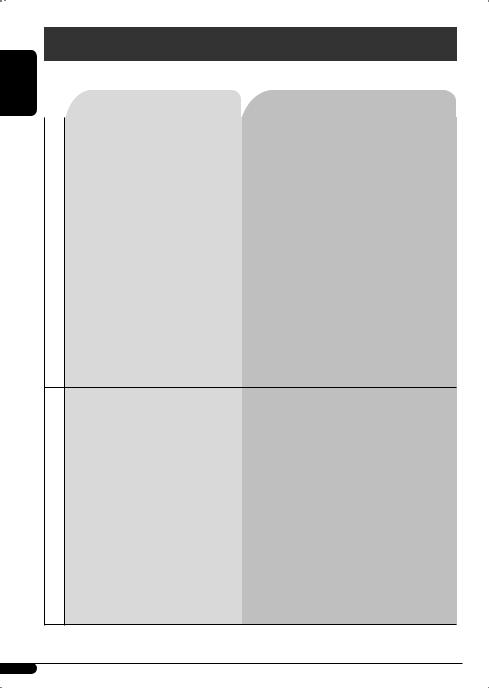
ENGLISH
Troubleshooting
What appears to be trouble is not always serious. Check the following points before calling a service center.
|
|
Symptoms |
Remedies/Causes |
|
|
|
|
General |
• |
Sound cannot be heard from the speakers. |
• Adjust the volume to the optimum level. |
|
|
• Check the cords and connections. |
|
|
|
|
|
|
• |
The unit does not work at all. |
Reset the unit (see page 2). |
|
|
|
|
FM/AM |
• |
SSM automatic presetting does not work. |
Store stations manually. |
|
|
|
|
• |
Static noise while listening to the radio. |
Connect the aerial firmly. |
|
|
|
|
|
|
• |
Disc cannot be played back. |
Insert the disc correctly. |
|
• |
CD-R/CD-RW cannot be played back. |
• Insert a finalized CD-R/CD-RW. |
|
• |
Tracks on the CD-R/CD-RW cannot be skipped. • Finalize the CD-R/CD-RW with the component which you |
|
|
|
|
used for recording. |
playback |
• |
Disc can be neither played back nor ejected. |
• Unlock the disc (see page 10). |
|
|||
|
|
|
• Eject the disc forcibly (see page 2). |
Disc |
• |
Disc sound is sometimes interrupted. |
• Stop playback while driving on rough roads. |
|
|
• Change the disc. |
|
|
|
|
|
|
|
|
• Check the cords and connections. |
|
• |
“NO DISC” appears on the display. |
Insert a playable disc into the loading slot. |
•“PLEASE” and “EJECT” appear alternately on the display.
|
• Disc cannot be played back. |
• Use a disc with MP3/WMA tracks recorded in a format |
||
|
|
|
compliant with ISO 9660 Level 1, Level 2, Romeo, or |
|
|
|
|
Joliet. |
|
R203)- |
|
|
• Add the extension code <.mp3> or <.wma> to the file |
|
|
|
names. |
||
|
|
|
||
KD |
• |
Noise is generated. |
Skip to another track or change the disc. (Do not add the |
|
(for |
|
|
extension code <.mp3> or <.wma> to non-MP3 or WMA |
|
|
|
tracks.) |
||
playback |
|
|
||
|
(“READING” keeps flashing on the display). |
Do not use too many hierarchical levels and folders. |
||
|
• A longer readout time is required |
|||
MP3/WMA |
|
|
|
|
• Tracks are not played back in the order you |
The playback order is determined when the files are |
|||
|
||||
|
|
have intended. |
recorded. |
|
|
• The elapsed playing time is not correct. |
This sometimes occurs during playback. This is caused by |
||
|
|
|
how the tracks are recorded on the disc. |
|
|
• The correct characters are not displayed (e.g. |
This unit can only display alphabets (upper case), |
||
|
|
album name). |
numbers, and a limited number of symbols. |
|
•Microsoft and Windows Media are either registered trademarks or trademarks of Microsoft Corporation in the United States and/or other countries.
18
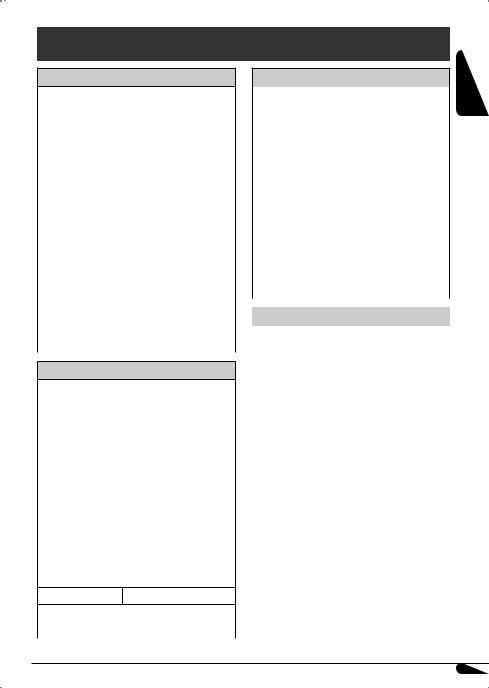
Specifications
AUDIO AMPLIFIER SECTION
Maximum Power Output:
Front/Rear: |
50 W per channel |
Continuous Power Output (RMS): |
|
Front/Rear: |
19 W per channel into 4 Ω, |
|
40 Hz to 20 000 Hz at no more |
|
than 0.8% total harmonic |
|
distortion. |
Load Impedance: |
4 Ω (4 Ω to 8 Ω allowance) |
Tone Control Range: |
|
Bass: |
±12 dB at 100 Hz |
Treble: |
±12 dB at 10 kHz |
Frequency Response: |
40 Hz to 20 000 Hz |
Signal-to-Noise Ratio: |
70 dB |
Line-Out Level/ |
2.5 V/20 kΩ load (full scale) |
Impedance: |
|
Output Impedance: |
1 kΩ |
Other Terminal: |
AUX (auxiliary) input jack |
TUNER SECTION
Frequency Range:
FM: |
87.5 MHz to 108.0 MHz |
|
AM: |
MW: |
522 kHz to 1 620 kHz |
|
LW: |
144 kHz to 279 kHz |
FM Tuner
Usable Sensitivity: |
11.3 dBf (1.0 μV/75 Ω) |
50 dB Quieting |
16.3 dBf (1.8 μV/75 Ω) |
Sensitivity: |
|
Alternate Channel |
65 dB |
Selectivity (400 kHz): |
|
Frequency Response: |
40 Hz to 15 000 Hz |
Stereo Separation: |
30 dB |
MW Tuner
Sensitivity/Selectivity: 20 μV/35 dB
LW Tuner
Sensitivity: |
50 μV |
CD PLAYER SECTION
Type: |
Compact disc player |
Signal Detection |
Non-contact optical pickup |
System: |
(semiconductor laser) |
Number of Channels: |
2 channels (stereo) |
Frequency Response: |
5 Hz to 20 000 Hz |
Dynamic Range: |
93 dB |
Signal-to-Noise Ratio: |
98 dB |
Wow and Flutter: |
Less than measurable limit |
For KD-R203 |
|
MP3 Decoding Format: (MPEG1/2 Audio Layer 3) |
|
Max. Bit Rate: |
320 kbps |
WMA (Windows Media® Audio) Decoding Format: |
|
Max. Bit Rate: |
192 kbps |
GENERAL |
|
Power Requirement: |
|
Operating Voltage: |
DC 14.4 V |
|
(11 V to 16 V allowance) |
Grounding System: |
Negative ground |
0°C to +40°C |
|
Allowable Operating |
|
Temperature: |
|
Dimensions (W × H × D): (approx.) |
|
Installation Size: |
182 mm × 52 mm × 160 mm |
Panel Size: |
188 mm × 58 mm × 13 mm |
Mass: |
1.3 kg (excluding accessories) |
Design and specifications are subject to change without notice.
ENGLISH
19
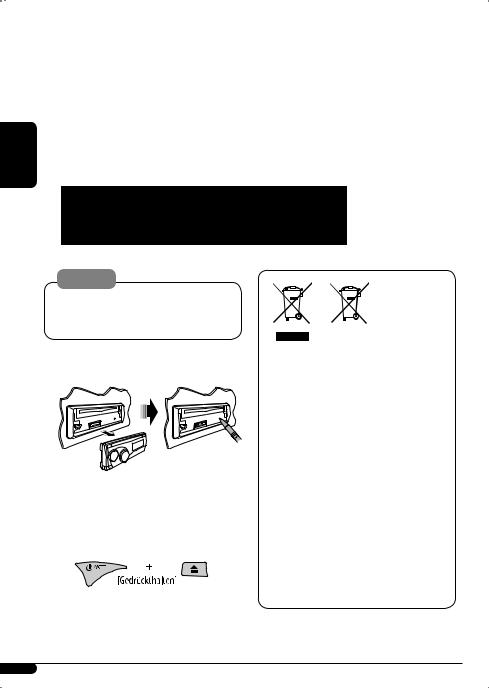
DEUTSCH
Wir danken Ihnen für den Kauf eines JVC Produkts.
Bitte lesen Sie die Anleitung vollständig durch, bevor Sie das Gerät in Betrieb nehmen, um sicherzustellen, daß Sie alles vollständig verstehen und die bestmögliche Leistung des Geräts erhalten.
WICHTIG FÜR LASER-PRODUKTE
1.LASER-PRODUKT DER KLASSE 1
2.ACHTUNG: Die obere Abdeckung nicht öffnen. Das Gerät enthält keine Teile, die vom Benutzer gewartet werden
können. Wartungen nur von qualifziertem Fachpersonal durchführen lassen.
3. ACHTUNG: Sichtbare und/oder unsichtbare Laserstrahlung der Klasse 1M bei offenen Abdeckungen. Nicht direkt mit optischen Instrumenten betrachten.
4. ANBRINGEN DES ETIKETTS: WARNHINWEIS-ETIKETT, AUSSEN AM GERÄT ANGEBRACHT.
Warnung:
Wenn Sie das Gerät beim Fahren bedienen müssen, dürfen Sie nicht den Blick von der Straße nehmen, da sonst die Gefahr von Verkehrsunfällen besteht.
 Zurücksetzen des Geräts
Zurücksetzen des Geräts
•Ihre vorgegebenen Einstellungen werden ebenfalls gelöscht.
 Zwangsweises Ausschieben einer Disc
Zwangsweises Ausschieben einer Disc
•Achten Sie darauf, die ausgeschobene Disc nicht fallen zu lassen.
•Wenn das nicht funktioniert, führen Sie einen Reset am Gerät aus.
Batterie
Produkte
Benutzerinformationen zur Entsorgung alter Geräte und Batterien
[Nur Europäische Union]
Diese Symbole zeigen an, dass das damit gekennzeichnete Produkt bzw. die Batterie nicht als normaler Haushaltsabfall entsorgt werden sollen. Wenn Sie dieses Produkt und die Batterie entsorgen möchten, halten Sie sich dabei bitte an die entsprechenden Landesgesetze und andere Regelungen in Ihrem Land bzw. Ihrer Gemeinde. Die korrekte Entsorgung dieses Produkts dient dem Umweltschutz und verhindert mögliche Schäden für die Umwelt und die menschliche Gesundheit.
Hinweis:
Das Zeichen Pb unterhalb des Batteriesymbols gibt an, dass diese Batterie Blei enthält.
2
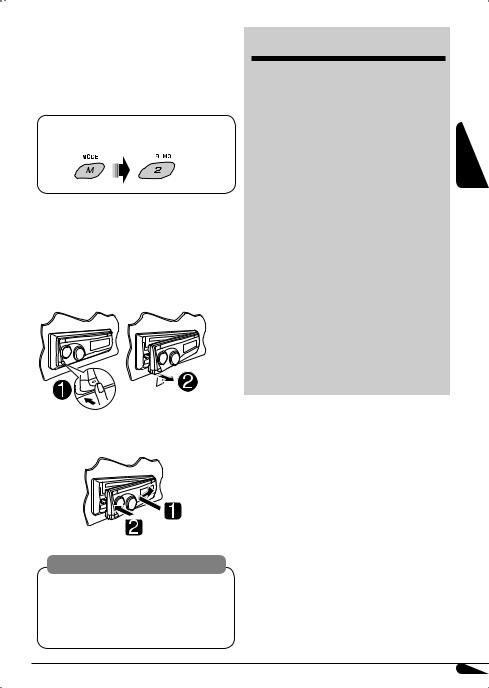
 Wie Sie die M MODE-Taste verwenden
Wie Sie die M MODE-Taste verwenden
Wenn Sie M MODE drücken, schaltet der Receiver auf Funktion-Modus, und die Zifferntasten sowie die 5 / ∞-Tasten arbeiten als andere Funktionstasten.
Beisp.: Wenn die Zifferntaste 2 als MO (Mono)- Taste fungiert.
Zur erneuten Verwendung dieser Tasten für ihre originale Funktion nach dem Drücken von M MODE warten Sie 5 Sekunden ohne Tastenbetätigung, bis der Funktion-Modus gelöscht wird, oder drücken Sie M MODE erneut.
 Abnehmen des Bedienfelds
Abnehmen des Bedienfelds
 Anbringen des Bedienfelds
Anbringen des Bedienfelds
Achtung bei der Lautstärkeeinstellung:
Discs erzeugen im Vergleich zu anderen Tonträgern sehr wenig Rauschen. Senken Sie die Lautstärke vor dem Abspielen einer Disc, um Beschädigung der Lautsprecher durch plötzliche Tonspitzen zu vermeiden.
INHALT |
|
Bedienfeld ...................................... |
4 |
Erste Schritte................................... |
5 |
Grundlegende Bedienung .................................... |
5 |
Bedienung des Tuners...................... |
6 |
UKW-Radio Data System-Funktionen... |
7 |
Suche nach bevorzugten UKW-Radio Data System |
|
-Sendungen ......................................................... |
7 |
Bedienung der Disc .......................... |
9 |
Abspielen einer Disc im Receiver ......................... |
9 |
Klangeinstellungen ......................... |
11 |
Allgemeine Einstellungen—PSM ..... |
12 |
Bedienung von anderen externen |
|
Komponenten ............................... |
15 |
Wartung ......................................... |
15 |
Weitere Informationen zu Ihrem |
|
Receiver....................................... |
16 |
Störungssuche................................. |
18 |
Technische Daten ............................ |
19 |
Für die Sicherheit...
•Die Lautstärke nicht zu laut stellen, da dadurch Außengeräusche überdeckt und das Autofahren gefährlich wird.
•Das Auto vor dem Durchführen von komplizierten Bedienschritten anhalten.
Temperatur im Auto...
Wenn Sie das Auto für lange Zeit in heißem oder kaltem Wetter parken, bitte warten, bis sich die Temperatur im Auto sich normalisiert hat, bevor Sie das Gerät einschalten.
DEUTSCH
3

Bedienfeld
Beschreibung der Teile
Displayfenster
DEUTSCH
|
|
|
|
|
|
|
|
|
|
|
|
|
|
|
|
|
|
|
|
|
|
|
|
|
|
|
|
|
|
|
|
|
|
|
|
|
|
|
|
|
|
|
|
|
1 |
0 (Auswurf)-Taste |
|||||||
2 |
4 / ¢ -Tasten |
|||||||
3 |
Ladeschlitz |
|||||||
4 |
|
|
|
(Standby/Dämpfung)-Taste |
||||
|
|
|
||||||
|
|
|
||||||
5 |
BAND-Taste |
|||||||
6 |
Displayfenster |
|||||||
7 |
T/P (Verkehrsprogramm/Programmtyp)-Taste |
|||||||
8 |
DISP (Display)-Taste |
|||||||
9 |
5 (höher) / ∞ (niedriger)-Tasten |
|||||||
p |
|
|
|
(Bedienfeld-Freigabe)-Taste |
||||
q SRC (Quelle)-Taste w Steuerregler
e SEL (Wählen)-Taste r M MODE-Taste
t EQ (Equalizer)-Taste
y MO (Mono)-Taste
u SSM (Sequentieller Speicher für starke Sender)-Taste i Zifferntasten
o RPT (Wiederholung)-Taste ; RND (Zufall)-Taste
a AUX (Hilfs-) Eingangsbuchse
sDiscinformation-Anzeigen—TAG* (TagInformation), (Titel/Datei),
(Titel/Datei), * (Ordner)
* (Ordner)
d DISC-Anzeige
fWiedergabemodus / Gegenstand-Anzeigen— RND (Zufall), (Disc),
(Disc), * (Ordner), RPT
* (Ordner), RPT
(Wiederholung)
g Radio Data System-Anzeigen—AF, REG, TP, PTY h Tuner-Empfangsanzeigen—MO (Mono), ST (Stereo) j LOUD (Loudness)-Anzeige
k EQ (Equalizer)-Anzeige l Tr (Titel)-Anzeige
/Quellenanzeige / Tracknummer / Lautstärkepegelanzeige / Zeit-Countdown-Anzeige
z Hauptdisplay
xSound-Modus (c-EQ: Spezieller Equalizer)- Anzeigen—JAZZ, ROCK, HIP HOP, CLASSIC, POPS, USER
* Für KD-R203
4

Erste Schritte
Grundlegende Bedienung 
~ Einschalten.
Ÿ









* Sie können nicht „CD“ als Wiedergabequelle wählen, wenn keine Disc im Gerät eingesetzt ist.
! Für UKW/AM-Tuner
⁄ Stellen Sie die Lautstärke ein.
Hier erscheint der
Lautstärkepegel.
@Stellen Sie den Klang nach Wunsch ein. (Siehe Seiten 11 und 12).
Zum abrupten Senken der Lautstärke (ATT)
Um die Lautstärke wieder anzuheben, drücken Sie die Taste erneut.
Zum Ausschalten des Geräts
Grundlegende Einstellungen
•Siehe auch „Allgemeine Einstellungen — PSM“ auf Seite 12 bis 14.
1
2 |
DEUTSCH |
|
1Abbrechen der Display-Demonstrationen
Wählen Sie „DEMO“, und dann „DEMO OFF“.
2Einstellung der Uhr
Wählen Sie „CLOCK H“ (Stunde), und stellen Sie dann die Stunde ein.
Wählen Sie „CLOCK M“ (Minute), und stellen Sie die Minute ein.
Wählen Sie „24H/12H“, und dann „24H“ (24 Stunden) oder „12H“ (12 Stunden).
3 Beenden Sie den Vorgang.
Zum Prüfen der aktuellen Uhrzeit, wenn das Gerät ausgeschaltet ist
Die Uhrzeit wird etwa 5 Sekunden lang im Display gezeigt. Siehe auch Seite 13.
5
